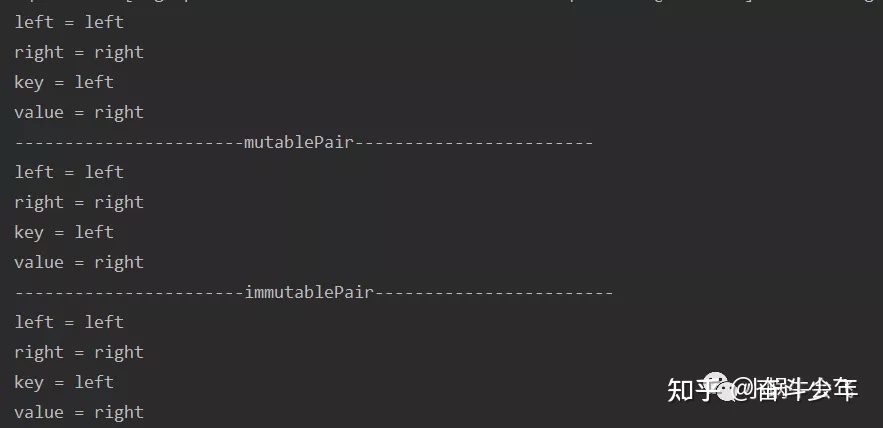您好,登錄后才能下訂單哦!
您好,登錄后才能下訂單哦!
這篇文章主要講解了“如何理解Java中的Pair”,文中的講解內容簡單清晰,易于學習與理解,下面請大家跟著小編的思路慢慢深入,一起來研究和學習“如何理解Java中的Pair”吧!
1 Pair用法
2 Pair源碼
3 ImmutablePair源碼
4 MutablePair源碼
5 疑問?
前言:
Java中的Pair在開發的過程中,無意中發現項目中有用到Pair,對于我之前從來沒有遇到過這個東西,覺得這個東西挺有意思,所以就記錄下。
在我們寫代碼的時候,肯定會遇到要返回兩個值,但是這兩個值都有用到,所以我們一般都會用map集合進行key-value封裝,或者寫一個類來封裝兩個屬性來返回,但是這兩種方式雖然實現起來簡單,但是感覺有點浪費類或者不美觀,如果大量的出現這種,就大量創建類或者map集合。為了解決這問題,強大的工具類-pair,這個類是在org.apache.commons.lang3.tuple包下的。
我們先來看看Pair用法:
@Test
public void TestPair() {
Pair<String,String> pair = Pair.of("left","right");
System.out.println("left = " + pair.getLeft());
System.out.println("right = " + pair.getRight());
System.out.println("key = " + pair.getKey());
System.out.println("value = " + pair.getValue());
Pair<String,String> mutablePair = new MutablePair<>("left","right");
System.out.println("-----------------------mutablePair------------------------");
System.out.println("left = " + pair.getLeft());
System.out.println("right = " + pair.getRight());
System.out.println("key = " + pair.getKey());
System.out.println("value = " + pair.getValue());
Pair<String,String> immutablePair = new ImmutablePair<>("left","right");
System.out.println("-----------------------immutablePair------------------------");
System.out.println("left = " + pair.getLeft());
System.out.println("right = " + pair.getRight());
System.out.println("key = " + pair.getKey());
System.out.println("value = " + pair.getValue());
}上面是比較簡單的列子,下面我們看下打印的結果:

上面就是打印的結果,其中MutablePair,ImmutablePair是pair的子類,這樣子就很方便的使用,不需要另外定義map集合和類來封裝了。
其實源碼也是算比較簡單的,Pair源碼如下:
//
// Source code recreated from a .class file by IntelliJ IDEA
// (powered by Fernflower decompiler)
//
package org.apache.commons.lang3.tuple;
import java.io.Serializable;
import java.util.Objects;
import java.util.Map.Entry;
import org.apache.commons.lang3.builder.CompareToBuilder;
public abstract class Pair<L, R> implements Entry<L, R>, Comparable<Pair<L, R>>, Serializable {
private static final long serialVersionUID = 4954918890077093841L;
public Pair() {
}
// 默認用的是子類ImmutablePair,
public static <L, R> Pair<L, R> of(L left, R right) {
return new ImmutablePair(left, right);
}
// 定義了抽象方法,目的子類去實現
public abstract L getLeft();
// 定義了抽象方法,目的子類去實現
public abstract R getRight();
// 這里的獲取key其實就是獲取getLeft()方法的值
public final L getKey() {
return this.getLeft();
}
// 這里的獲取value 其實就是獲取getRight()方法的值
public R getValue() {
return this.getRight();
}
// 這里就是比較兩個Pair
public int compareTo(Pair<L, R> other) {
return (new CompareToBuilder()).append(this.getLeft(), other.getLeft()).append(this.getRight(), other.getRight()).toComparison();
}
public boolean equals(Object obj) {
if (obj == this) {
return true;
} else if (!(obj instanceof Entry)) {
return false;
} else {
Entry<?, ?> other = (Entry)obj;
return Objects.equals(this.getKey(), other.getKey()) && Objects.equals(this.getValue(), other.getValue());
}
}
public int hashCode() {
return (this.getKey() == null ? 0 : this.getKey().hashCode()) ^ (this.getValue() == null ? 0 : this.getValue().hashCode());
}
public String toString() {
return "(" + this.getLeft() + ',' + this.getRight() + ')';
}
public String toString(String format) {
return String.format(format, this.getLeft(), this.getRight());
}
}上面的源碼就是簡單的定義了我們常規的方法,getLeft()和getRight()方法留給子類去實現,父類默認采用的是ImmutablePair子類,Pair還實現了Entry<L,R>,可以使用getKey()和getValue() ,其實它們都是調用了getLeft()和getRight()方法,繼承了Comparable,可以比較兩個Pair。繼承了Serializable,可以被序列化。
我們看看ImmutablePair源碼:
//
// Source code recreated from a .class file by IntelliJ IDEA
// (powered by Fernflower decompiler)
//
package org.apache.commons.lang3.tuple;
// 繼承了Pair
public final class ImmutablePair<L, R> extends Pair<L, R> {
private static final ImmutablePair NULL = of((Object)null, (Object)null);
private static final long serialVersionUID = 4954918890077093841L;
// 這里用了final修飾,代表的left值設值之后是不可變
public final L left;
// 這里用了final修飾,代表的right值設值之后是不可變
public final R right;
public static <L, R> ImmutablePair<L, R> nullPair() {
return NULL;
}
public static <L, R> ImmutablePair<L, R> of(L left, R right) {
return new ImmutablePair(left, right);
}
public ImmutablePair(L left, R right) {
this.left = left;
this.right = right;
}
public L getLeft() {
return this.left;
}
public R getRight() {
return this.right;
}
// 因為是不可變的值,所以如果set值的話直接拋異常
public R setValue(R value) {
throw new UnsupportedOperationException();
}
}ImmutablePair源碼很簡答,只是變量加了final修飾,是不可變的,所以在調用setValue()方法時,就會拋出異常:UnsupportedOperationException。
MutablePair源碼如下:
//
// Source code recreated from a .class file by IntelliJ IDEA
// (powered by Fernflower decompiler)
//
package org.apache.commons.lang3.tuple;
public class MutablePair<L, R> extends Pair<L, R> {
private static final long serialVersionUID = 4954918890077093841L;
public L left;
public R right;
public static <L, R> MutablePair<L, R> of(L left, R right) {
return new MutablePair(left, right);
}
public MutablePair() {
}
public MutablePair(L left, R right) {
this.left = left;
this.right = right;
}
public L getLeft() {
return this.left;
}
public void setLeft(L left) {
this.left = left;
}
public R getRight() {
return this.right;
}
public void setRight(R right) {
this.right = right;
}
// 這里set value值,會返回舊value值
public R setValue(R value) {
R result = this.getRight();
this.setRight(value);
return result;
}
}上面的MutablePair源碼跟ImmutablePair源碼不同之處就是MutablePair可變,ImmutablePair不可變。
如果要求返參不止2個,3個怎么辦???
沒問題,一樣滿足你,在這個org.apache.commons.lang3.tuple包中提供了針對構建三個元素的Triple類,類定義中abstract class Triple<L, M, R>。定義了3個泛型同樣提供了ImmutableTriple和MutableTriple一對不可變和可變的實現類,源碼跟上面的差不多,只是多加了個變量屬性而已。
那如果4個范參,5個范參呢,那不好好意思,你只能通過定義bean封裝返回,或者map集合返回。
感謝各位的閱讀,以上就是“如何理解Java中的Pair”的內容了,經過本文的學習后,相信大家對如何理解Java中的Pair這一問題有了更深刻的體會,具體使用情況還需要大家實踐驗證。這里是億速云,小編將為大家推送更多相關知識點的文章,歡迎關注!
免責聲明:本站發布的內容(圖片、視頻和文字)以原創、轉載和分享為主,文章觀點不代表本網站立場,如果涉及侵權請聯系站長郵箱:is@yisu.com進行舉報,并提供相關證據,一經查實,將立刻刪除涉嫌侵權內容。